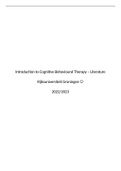Summary
Summary of literature for Intro to CBT
- Course
- Institution
I summarised all the necessary chapters from the book: Farmer and Chapman (chapter 1, 2, 3, 4, 7, 8, 9) and Judith Beck (chapter 1, 3, 12, 13, 14, 15, 17, 18) as well as several articles required. The course talks about CBT, mostly exposure therapy and schema therapy.
[Show more]



